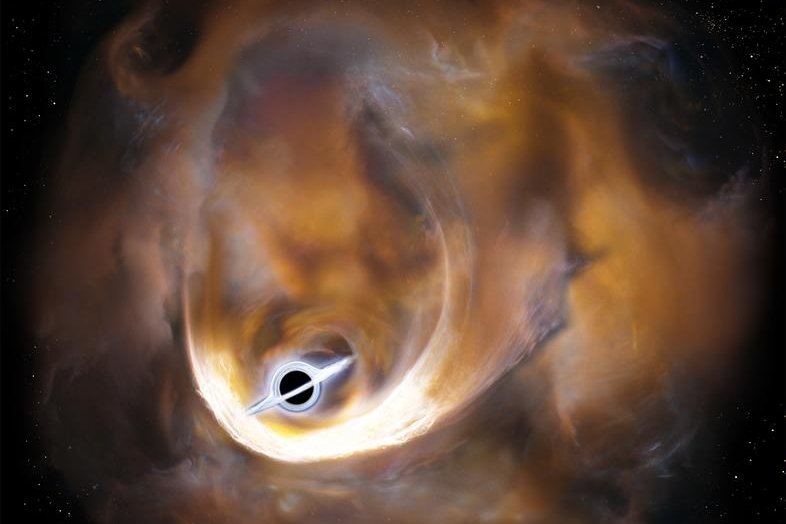An artistic rendering of the gas cloud created by an intermediate mass black hole. Photo by Tomoharu Oka/Keio University
MINATO, Japan, Jan. 15 (UPI) -- A team of astronomers in Japan have discovered evidence of what they call an "intermediate mass" black hole near the center of the Milky Way galaxy.
The findings may offer insights to the birth and evolution of supermassive black holes found in the center of nearly all large galaxies.
Researchers were clued in to the possible presence of a black hole by an unusual gas cloud called CO-0.40-0.22. The gas cloud intrigued scientists because its gas appeared to be moving at a wide range of velocities.
The astronomers decided to take a closer look with the Nobeyama 45-m Telescope.
Their findings revealed an elliptically shaped cloud formed by two components: a compact, low-density component with an extremely wide velocity dispersion and a larger, denser component stretching 10 light-years across and boasting a much narrower velocity dispersion.
Velocity dispersion describes the range of speeds at which matter is moving. A wide dispersion rate correlates with more chaotic, random and high-energy movement -- characteristics that might describe the accretion disk around a black hole.
In an attempt to understand what might explain the cloud and its wide dispersion rate, researchers conducted X-ray and infrared scans of the object. They turned up no compact objects or pockets of space within the cloud.
The team then designed a computer model to simulate the enigmatic gas cloud. Their model found a gravity source with a mass of 1,000 suns best explained the observable data -- in other words, a moderately sized black hole.
Researchers published their findings in the Astrophysical Journal Letters.
"Considering the fact that no compact objects are seen in X-ray or infrared observations," lead study author Tomoharu Oka, a professor at Keio University in Japan, explained in a press release, "as far as we know, the best candidate for the compact massive object is a black hole."
Currently, there are two confirmed categories of black holes stellar-mass black holes and supermassive black holes. Stellar-mass black holes are formed by the violent explosions of very massive stars. Scientist aren't sure how supermassive black holes are formed.
Some astronomers suggest they are the formed by merging intermediate-mass black holes. But until now, there was little to no evidence for intermediate black holes.
If CO-0.40-0.22 is indeed a black hole, it may help explain the formation and evolution of supermassive black holes. It also may reveal the locations of dozens of other hard-to-find black holes.
Although surveys suggest there are upwards of 200 black holes in the Milky Way, astronomers have only found hard evidence of 12. The latest observations suggest many may be hiding in oddly shaped gas clouds with a wide dispersion velocity.
"Investigations of gas motion with radio telescopes may provide a complementary way to search for dark black holes," Oka said. "The on-going wide area survey observations of the Milky Way with the Nobeyama 45-m Telescope and high-resolution observations of nearby galaxies using the Atacama Large Millimeter/submillimeter Array have the potential to increase the number of black hole candidates dramatically."















